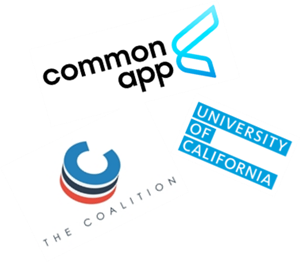Application Checklist
• Application Form
• SAT/ACT Score
• Personal Essay/Statement
• Letters of Recommendation (one from a counselor & one from a teacher)
• High School Profile (from a counselor)
• Transcript (9th – 12th grade)
Application Forms
Common Application
The Common Application (more commonly known as the Common App) is an undergraduate college admission application that applicants may use to apply to over 1,000 member colleges and universities in all 50 U.S. states and the District of Columbia, as well as in Canada, China, Japan, and many European countries. The Common App has been around since 1975 and is by far the most popular and widely used centralized application system.
The Common App requires students to write an essay of up to 650 words, based on a topic chosen from a list of seven prompts.
Click here to visit the Common App site.
Coalition Application
The Coalition for College, formerly the Coalition for Access, Affordability, and Success (CAAS), is an American nonprofit organization that runs the Coalition Application, a U.S. college application platform. It was founded in 2015, aiming to provide a holistic application that assists disadvantaged students.
With a focus on access and affordability, the Coalition requires member schools to demonstrate support for low-income students. Currently over 150 colleges and universities use the Coalition Application. The platform is unique in offering a virtual “locker” where students can store application materials as early as ninth grade.
The Coalition App requires students to choose from five essay prompts. There is no word limit although the recommendation is 500-550.
Click here to visit the Coalition App site.
University of California (UC) Application
The UC App is used by all schools in the UC system, which includes the Berkeley, Los Angeles, and San Diego campuses. (Note that the California State University system, which includes Cal Poly San Luis Obispo, uses its own application platform.) One unique aspect of the UC app is its requirement that students self-report classes and grades on the application itself rather than submit official transcripts, which aren’t required until after the student is admitted.
The UC App asks students to write four essays of up to 350 words each, in response to what they call “Personal Insight Questions” (PIQ). Students choose from a list of eight Personal Insight Questions.
Click here to visit the UC App site.
ApplyTexas
ApplyTexas is an application used by a number of institutions in Texas, including all public universities as well as many private schools, HBCUs, Hispanic serving universities, and community colleges. Note that most ApplyTexas schools give students the option to use another application platform in lieu of ApplyTexas.
ApplyTexas offers three essay prompts, but each school specifies which prompt they want students to choose (sometimes they will allow students to choose from any of the three).
Click here to visit the ApplyTexas site.
Application Timeline
Early Decision (ED)
• Apply by November 15 – responded by December 15.
• You can apply ED to only one college because acceptance is binding.
• You should have a clear first-choice college – apply early and commit to attend if admitted.
• ED involves a binding contract in which a student promises to enroll in the school if accepted.
When applying ED, the student agrees to enroll before seeing the financial aid offer.
• You can’t change your mind after being accepted unless the financial aid package offered does not meet your family’s need.
• Legacy applicants and recruited athletes are encouraged to use ED as a strategy.
Advantages:
• For college – they know the yield from the pool of ED acceptances, so they can better predict their needs for marketing.
• For student – 2-3 times higher acceptance rate – from 1/3 to over a half of freshman classes are filled by ED.
Disadvantages:
• Limited financial aid options.
• ED admits cannot compare financial aid offers from several schools – preventing from obtaining a more desirable package.
Who should apply ED?
• If you have a clear first-choice college after careful research.
• If you don’t need grades from the full first semester of your senior year to bolster your academic record.
• If you have taken your standardized tests by October of your senior year so that the scores would reach in time for November application.
• If your overall record places you within the admissible range for the target college.
• If you have organizational skills and time to prepare a strong early application including letters of recommendation and personal essay.
• If you don’t need to compare financial aid offers.
Early Action (EA)
• Apply by November 15 – responded by December 15.
• Make final decision by May 1.
• No binding commitment but still an early response from a desired college.
• Some early action schools place restrictions on ED/EA applications to other colleges.
• EA admissions boost is much smaller than ED admissions.
Rolling Admission (RA)
In contrast, schools with a regular decision policy require you to submit your application by a certain deadline — usually in late December or January.

